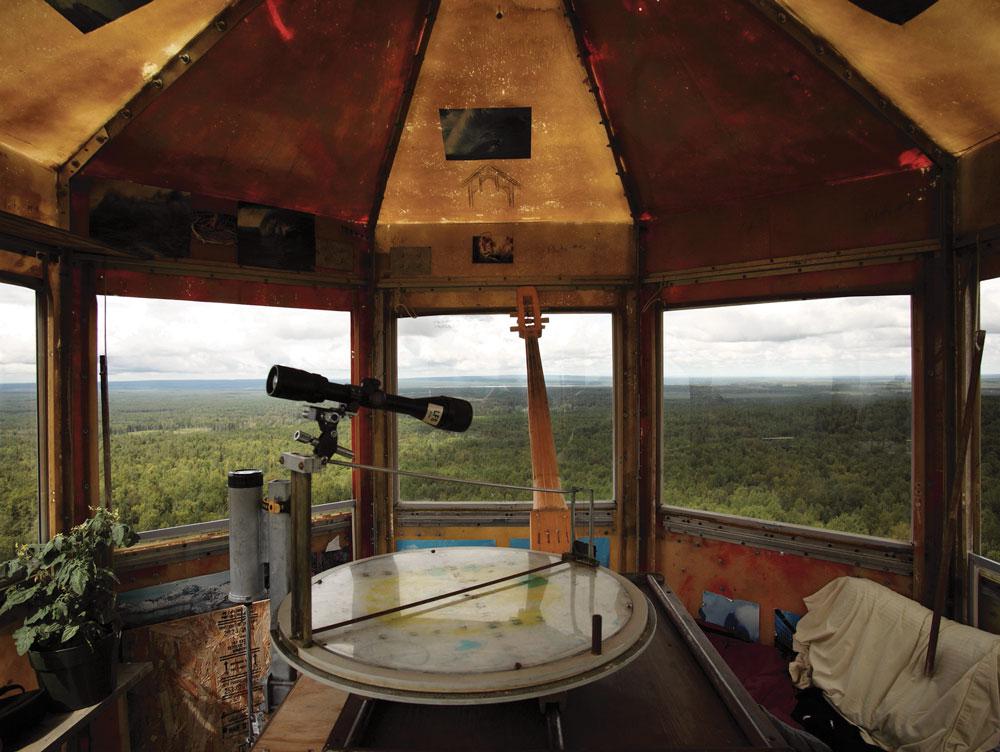Jason de Haan and his wife, Miruna Dragan, are artists who most often live in Calgary, but they were recently based in Lebanon. While abroad, de Haan told Dragan about a trip he took to see a longtime friend, Daniel Bosch, in northern Alberta, where Bosch works as a wildfire lookout from April to October. He described Bosch’s latest invention: a bodiless cello carved from solid spruce that Bosch built to accommodate his daily climb up the 120 vertical steps of the caged ladder to the 2.5-by-2.5-metre octagonal cupola of the lookout tower. Bosch had discovered that he could wedge this practice cello between the edge of a small table and the wall of the tower’s fibreglass cupola, and practice his music throughout the long, northern daylight hours of his watch. The cupola itself functioned as the resonant body of the cello, and Bosch’s music could be heard across kilometres of unpopulated wilderness.
Dragan, who is experienced with video and sound, was excited by the possibility of witnessing and documenting Bosch performing with his hybrid instrument and, some months later, in July 2011, she and de Haan made the trip north.
Up in Bosch’s tiny tower room, the artists positioned a record turntable in the centre of the room and connected it to a slower external motor to make a revolving pedestal for the video camera. They calibrated the apparatus to rotate through the entire forest horizon at a pace that mirrored the patient scrutiny demanded of those who must watch for fires for hours on end. They pointed the two built-in microphones of a small digital sound recorder toward the walls of the tower room, and trained two directional microphones on Bosch’s cello.
In the darkened ballroom space of the Khyber Centre, the projected video filled a wall, and, true to Bosch’s promise, the amplified sound of his bodiless cello/tower-room instrument resonated far and wide. In the video, the revolving camera passes Bosch every minute and a half or so, as he plucks and bows his cello, teasing out robust and inventive strains (he is self-taught—an earlier personal project that also evolved in the Alberta wilderness) that score the continuous panorama unfolding through the windows. For 38 continuous minutes, as a fading sun casts the forest into deep shadow and the performer into silhouette, our gaze replaces his, though we are fixed less on potential flames than we are on the uncanny clarity produced by these simple means. Without being in the tower cupola, it is hard to imagine what has been lost. We hear the soft mechanical whirr and drone of the camera’s turntable beneath the music, and we witness an entire northern sunset.
It’s possible, as with most things that look both perfect and simple, that much trial and error underlies The Wood and Wave Each Other Know, but the whole enterprise has the feel of everyone, companionably, doing everything just right.
De Haan and Dragan produced a poster-sized book to accompany the video work, in which 18 pages of images document Bosch, his bodiless cello and another, complete cello—also carved from solid spruce—the fire tower, the landscape and other details of his daily life in the wilderness. Many of the images spread, panoramically, across two pages, and resemble the shape of the view in the video. A stanza of Ralph Waldo Emerson’s poem “Wood Notes II,” in which the title of the work was found, appears on the final page: “The wood is wiser far than thou: / The wood and wave each other know.”
From the Spring 2012 issue of Canadian Art.









